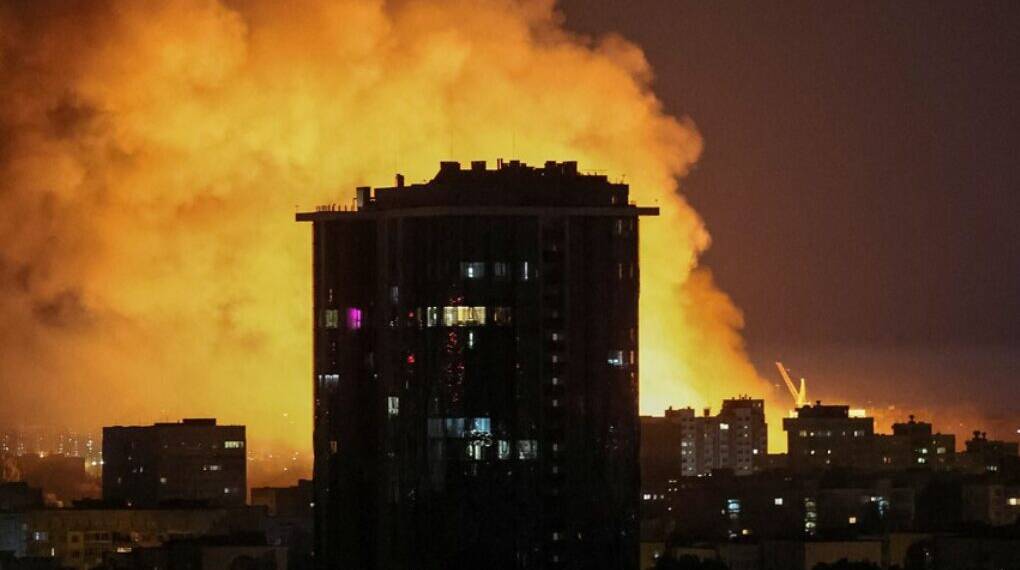In what Ukrainian officials are calling the most extensive aerial attack since the beginning of the war, Russia launched a staggering 550 drones and missiles overnight, targeting key infrastructure in the capital Kyiv and other cities across Ukraine. The onslaught began just hours after a widely publicized phone call between Russian President Vladimir Putin and U.S. President Donald Trump, raising alarms about the Kremlin’s intentions and the global response to the conflict.
Ukrainian authorities reported at least 23 injuries from the barrage, with 14 individuals hospitalized. Civilian sites were heavily damaged, including residential buildings, schools, a medical facility, and railway infrastructure. Fires ignited by falling drone debris were confirmed in multiple districts by NASA satellite data. Zhuliany International Airport and industrial areas near Vasylkiv Airbase were among the critical sites hit.
“This was one of the most cynical and destructive nights Kyiv has endured,” said Ukrainian President Volodymyr Zelenskyy. “The timing of the strikes—coinciding almost exactly with media reports of the Trump-Putin call—makes Russia’s intentions crystal clear. Without increased international pressure, they will not stop.”
Phone Call Fallout: Trump “Disappointed” in Putin
Thursday’s call between Trump and Putin lasted nearly an hour and covered a wide range of topics, including the war in Ukraine and regional security issues. Trump later told reporters the conversation yielded “no progress” toward ending the conflict.
“I’m very disappointed,” Trump said, adding, “Putin is not looking to stop the war.”
The Kremlin, in contrast, described the conversation as “frank and constructive.” According to Kremlin adviser Yuri Ushakov, Putin reaffirmed Russia’s resolve to continue pursuing its military objectives in Ukraine, stating unequivocally that Moscow “will not back down.”
Russian state media claimed that Putin did not address the recent U.S. decision to pause certain weapons shipments to Ukraine. However, Trump confirmed he plans to speak with Zelenskyy later today to discuss the issue. “We’ve given so many weapons,” Trump said, “but Biden emptied our stockpiles. We have to protect ourselves first.”
Air Attack Details: A Night of Terror
According to Ukraine’s Air Force, of the 550 aerial weapons launched, 476 drones were successfully intercepted, along with several cruise and ballistic missiles. Still, dozens reached their targets. Kyiv’s mayor, Vitali Klitschko, said damage was recorded in six of the city’s ten districts, with one medical facility catching fire after being struck.
Residents spent hours in underground shelters, metro stations, and parking garages as air raid sirens wailed for over eight hours. Thick smoke choked several neighborhoods, prompting officials to warn about hazardous air conditions.
“Horrible and sleepless night in Kyiv. One of the worst so far,” said Ukraine’s Foreign Minister Andrii Sybiha.
Russia Also Hit: Ukrainian Drones Strike Near Moscow
Ukrainian drones reportedly struck targets near Moscow overnight, including a power substation in Sergiyev Posad, injuring one and leaving thousands without electricity. Russian officials said their air defenses downed 48 Ukrainian drones over five regions.
The tit-for-tat aerial strikes reflect the escalating intensity of the conflict, particularly as diplomatic efforts falter.
International Reactions and Aid Uncertainty
Zelenskyy called the attacks “demonstratively significant and cynical,” urging the United States and NATO to maintain—and even increase—pressure on Moscow.
“The only way to stop this madness is with firm, coordinated action: sanctions, isolation, and sustained military support,” Zelenskyy said. “It depends on our partners, primarily the United States.”
The future of that support remains unclear. Trump’s administration has paused several shipments of air defense systems to Ukraine, citing the need to safeguard U.S. stockpiles. While State Department officials insist support for Ukraine remains unchanged, the pause has already triggered anxiety in Kyiv and among NATO allies.
A Shift in Strategy?
Since June, Russia has intensified its air campaign, launching thousands of combat drones and gliding bombs. Analysts suggest Moscow is testing Ukraine’s defenses—and the West’s resolve.
Military analyst Michael Clarke, speaking to Sky News, warned that “Russia is now leveraging sheer volume and exhaustion tactics. This is war by attrition—not just on the battlefield, but politically as well.”
As Kyiv picks through the rubble and prepares for more assaults, the message from Moscow appears clear: Russia is not backing down. With diplomacy stalling and U.S. military support under review, Ukraine enters yet another phase of a grinding war, with no end in sight.








